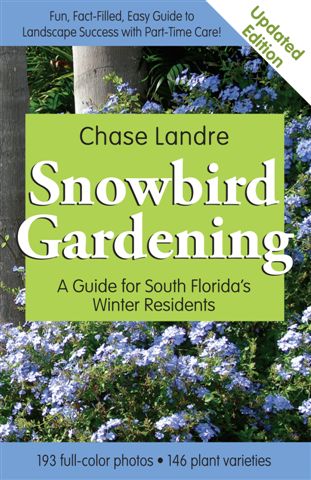Snowbird Gardening
A Guide for South Florida's
Winter Residents
SOLD OUT!
(but now available as an ebook!)
Here it is...
...the book that provides practical gardening advice for Snowbirds!

All the answers you need for
$19.95
193 Color Photographs!
146 Plant Varieties!
In Snowbird Gardening you will...
- Learn about South Florida's easiest-to-grow palms, trees, and flowers - full-color photos and complete care guide for 146 plant varieties
- Learn how to grow citrus, maintain a healthy lawn, plant using soil amendments, deal effectively with pests, and the ins and outs of fertilization & irrigation
- Get answers on when to plant, when and how much to trim, common myths, and the 10 Keys to Success
- Discover ways to keep your Florida landscaping low maintenance and beautiful year-round - with only part-time care!
A reader says...
"My father, who is an avid gardener, found the book to be just what he's been looking for since moving from Connecticut to South Florida.
"He is trying to find his way with gardening down here & has found this book to be the most helpful one yet that he has read. Pictures, to the point with short descriptions. Gives you just what you need."
It all started when...
...I worked for a plant nursery and garden center. Whenever Snowbird Season began, I'd get asked the same questions. Over and over.
And finally the light bulb went on!
You people need a manual!
A book to guide you through the difference between gardening at "home" and growing things here.
- Dealing with the soil - or rather, sand! - in our garden beds
- What plants are low maintenance and can survive with no one here all summer to care for them
- Which plants look great in winter and which ones to avoid
- When and how to do the basic care our subtropical plants need
Get real answers today!
$19.95
Snowbird Gardening provides practical answers to the unique challenges of gardening for South Florida's Winter Residents!
A breezy enjoyable read, full of facts you'll refer to again and again!
Snowbird Gardening will become your gardening companion handbook for life!
A reader says...
"I originally took this book out from the library and it quickly became my favorite summer read this year! So much so, I had to order one! I like the pictures & to the point descriptions. I also like your humor at the end of the book."
Want an overview?
Read this review in the Miami Herald by gardening author Georgia Tasker
"This friendly, small book is aimed squarely at an audience that contends with being absent in the rainy season and present during the dry season.
"So Landre suggests hardy plants that are low maintenance and colorful
over winter: crown of thorns, crotons, Hong Kong orchid tree, desert
cassia, bougainvillea, pentas, society garlic and the like.
"She also likes palms, particularly the pygmy date palm.
"She counsels her snowbirds to stay away from frangipani, which is leafless during winter. And she urges them to consider dwarf and plants that grow ever-so-slowly and won't jump the fence over summer.
"A Bradenton gardener, Landre's list of common garden mistakes for winter residents is full of experienced truth.
"Mistakes include planting too close to the house, walkways, drives, other plants; not considering the ultimate size of a plant; expecting nature to water plants when away; planting right before leaving; taking advice from neighbors, brothers-in-law '...or anyone else who doesn't grow/sell plants for a living.'
"She includes a helpful list of plants that will take winter sun and summer shade as well as winter shade and summer sun. She advises on fertilizers and planting techniques.
"Most of the book consists of nice photographs of the 146 plants that she likes, with short descriptions that include important data about plant height, sun needs and whether each is fast or slow growing. For shrubs and groundcovers, she includes how far apart to plant.
"Landre cautions against planting citrus because of the maintenance required, and she notes that citrus greening disease may make some varieties hard to find."